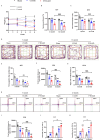FTO (fat-mass and obesity-associated protein) deficiency aggravates age-dependent depression-like behaviors and cognitive impairment
- PMID: 40518522
- PMCID: PMC12167586
- DOI: 10.1186/s12993-025-00280-3
FTO (fat-mass and obesity-associated protein) deficiency aggravates age-dependent depression-like behaviors and cognitive impairment
Abstract
Background: The demethylase fat mass and obesity-related associated protein (FTO) is strongly associated with depression. Aging is a risk factor for synaptic plasticity damage in the brain and leads to neurocognitive dysfunctions. FTO-dependent m6A modification plays an important role in neurodevelopment and cognitive function. However, whether FTO is associated with susceptibility to depression in different age groups remains unknown.
Methods: We subjected 3-and 12-month-old C57BL/6J male mice to chronic unpredictable mild stress (CUMS) for 6 weeks, of which 3 weeks were used for hippocampal injection of FTO knockdown adeno-associated virus 9 shRNA (FTO-KD AAV9). Finally, 36 male mice in each 3-month-old and 12-month-old groups were divided into three groups (n = 12): Sham, CUMS, and FTO-KD. After 6 weeks, we assessed behavioral deficits (depressive and anxiety-like behaviors and cognitive impairment) by behavioral tests and hippocampal neuronal damage (dendritic spine density, neuronal atrophy, and expression of proteins associated with synaptic plasticity) by molecular biochemical experiments.
Results: The results showed that 12-month-old C57BL/6J mice were more likely to develop depression-like behavior and spatial learning and memory impairment induced by CUMS than 3-month-old mice. Chronic stress-induced depression-like behavior and cognitive impairment worsened after the FTO-KD intervention. In the hippocampus of 3- and 12-month-old mice, CUMS induced the downregulation of FTO, nerve growth factor (NGF), reelin, and synaptic plasticity-related proteins. It also caused abnormal brain-derived neurotrophic factor (BDNF)- the tropomyosin-related kinase B (TrkB) signaling, reduced density of dendritic spines, and an increased number of neuronal pyknotic nuclei, leading to neuronal disarray, which was more significant in 12-month-old animals. FTO deficiency accelerated neuronal damage in the hippocampus of 12-month-old CUMS mice.
Conclusions: This study provides rodent evidence that FTO deficiency may increase the susceptibility to depression in older adults by impairing hippocampal neuronal function and neuronal synaptic plasticity in an age-dependent manner. This suggests that the development of FTO activators may be an effective treatment for depression in older adults.
Keywords: BDNF-TrkB signaling pathway; Chronic unpredictable mild stress (CUMS); Cognitive impairment; FTO; Synaptic plasticity.
© 2025. The Author(s).
Conflict of interest statement
Declarations. Ethics approval and consent to participate: The Ethics Committee of Chaohu Hospital affiliated to Anhui University of Medical Science approved all animal experiments (KYXM-202112-010). Consent for publication: Not applicable. Competing interests: The authors declare no competing interests.
Figures









Similar articles
-
The enriched environment ameliorates chronic unpredictable mild stress-induced depressive-like behaviors and cognitive impairment by activating the SIRT1/miR-134 signaling pathway in hippocampus.J Affect Disord. 2019 Apr 1;248:81-90. doi: 10.1016/j.jad.2019.01.031. Epub 2019 Jan 28. J Affect Disord. 2019. PMID: 30716615
-
Role of Fto on CaMKII/CREB signaling pathway of hippocampus in depressive-like behaviors induced by chronic restraint stress mice.Behav Brain Res. 2021 May 21;406:113227. doi: 10.1016/j.bbr.2021.113227. Epub 2021 Mar 5. Behav Brain Res. 2021. PMID: 33677012
-
Hippocampal SorCS2 overexpression represses chronic stress-induced depressive-like behaviors by promoting the BDNF-TrkB system.Pharmacol Biochem Behav. 2024 Sep;242:173820. doi: 10.1016/j.pbb.2024.173820. Epub 2024 Jul 10. Pharmacol Biochem Behav. 2024. PMID: 38996926
-
Role of proBDNF and BDNF in dendritic spine plasticity and depressive-like behaviors induced by an animal model of depression.Brain Res. 2017 May 15;1663:29-37. doi: 10.1016/j.brainres.2017.02.020. Epub 2017 Mar 8. Brain Res. 2017. PMID: 28284898
-
BDNF effects on dendritic spine morphology and hippocampal function.Cell Tissue Res. 2018 Sep;373(3):729-741. doi: 10.1007/s00441-017-2782-x. Epub 2018 Feb 15. Cell Tissue Res. 2018. PMID: 29450725 Review.
References
-
- Afridi MI, Hina M, Qureshi IS, Hussain M. Cognitive disturbance comparison among drug-naive depressed cases and healthy controls. J Coll Physicians Surg Pak. 2011;21(6):351–5. - PubMed
-
- Rock PL, Roiser JP, Riedel WJ, Blackwell AD. Cognitive impairment in depression: a systematic review and meta-analysis. Psychol Med. 2014;44(10):2029–40. 10.1017/S0033291713002535. - PubMed
-
- Malhi GS, Mann JJ. Depression. Lancet. 2018;392(10161):2299–312. 10.1016/S0140-6736(18)31948-2. - PubMed
-
- Bhalla RK, Butters MA, Mulsant BH, Begley AE, Zmuda MD, Schoderbek B, Pollock BG, Reynolds CF 3rd, Becker JT. Persistence of neuropsychologic deficits in the remitted state of late-life depression. Am J Geriatr Psychiatry. 2006;14(5):419–27. 10.1097/01.JGP.0000203130.45421.69. - PubMed
MeSH terms
Substances
Grants and funding
LinkOut - more resources
Full Text Sources
Medical

